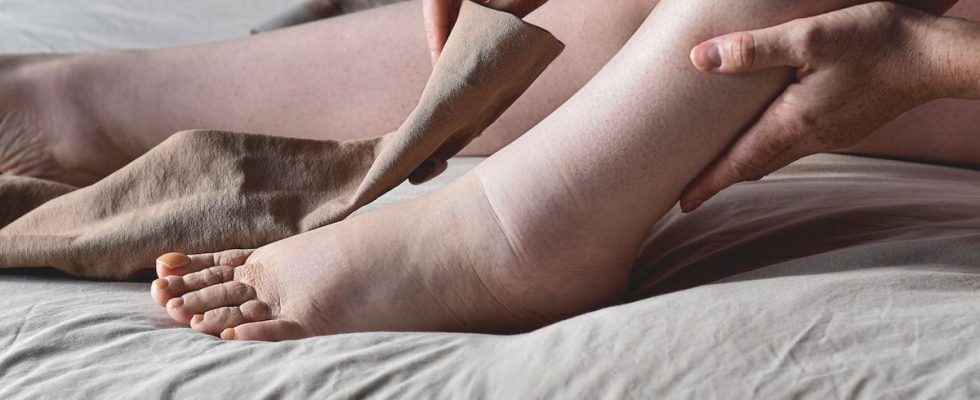Published on
Updated
Reading 4 mins.
in collaboration with
Dr. Ariel Toledano (Vascular Physician)
Mahogany Geter is a young American model who since birth has suffered from lymphedema in her left leg. On social networks, his photos are the buzz, because of the impressive size of his affected leg. Dr. Ariel Toledano, angiologist in Paris, specializing in vascular medicine, provides an update on this pathology.
In 2019, on his Instagram account, Mahogany Geter shares his story. Since childhood, she has faced discrimination because of her illness. This young 23-year-old model suffers from lymphedema, which is the cause of a very visible handicap: the extreme size of her left leg, which now weighs nearly 45 kg.
Victim of teasing since his earliest childhood
“I was born with a condition called lyphoedema which causes fluids to build up on one side of the body due to a lack of functioning lymphatic system. It does not only affect you physically but also mentally. It’s hard to live with that because you just want to feel normal and not be stared at by everyone in public.” explains the model on a instagram post.
Today, she proudly displays herself on her Instagram account. “When I was younger I felt like God had cursed me, I didn’t feel pretty or cute, every time I walked past a mirror and saw my legs I was drowning in sadness , I was crying in my room. As I got older, I learned to accept myself better. (…) I wanted to promote the fact that it is beautiful to be different (…) This is for all those who struggle with disabilities or lack of self-confidence”adds the model on the same Instagram post.
Lymphedema remains a “complex problem and today, we do not know how to manage this kind of situation”says Dr. Ariel Toledano, angiologist during an interview for Doctissimo.
“A rare and complex chronic disease”
First of all, Dr. Ariel Toledano would like to point out that lymphedema is a rare and very “feminine” disease. Indeed, 2/3 of people affected by lymphedema are women.
There are two types of lymphedema that need to be clearly distinguished when diagnosing the disease.
- Primary lymphedema – like the extremely rare case of Mahogany Geter – corresponds to a “malformation of the lymphatic system (a circulatory system made up of lymphatic vessels similar to blood vessels that allow lymph to circulate) linked to the significant absence of the number of lymphatic connectors or the absence of entire portions of the lymphatic system (aplasia). This generates a poor return of the lymph and therefore leads to a more or less pronounced enlargement of the leg”;
- Secondary lymphedema corresponds to a “non-congenital destruction of the lymphatic system. It follows surgery on a patient who is operated on for a tumor and who has a few lymph nodes removed to prevent the cancer from spreading. But this handicaps the lymphatic return. The the most common case is axillary dissection after breast cancer (removal of lymph nodes located under the arm in the armpit). We end up with lymphedema of the arm (or “big arm”)”says Dr. Toledano.
Lymphedema: what possible treatments?
According to Dr. Toledano, it is essential to establish a diagnosis before thinking of any treatment to help patients suffering from lymphedema. For that, “it is necessary to carry out a clinical evaluation taking into account the whole of the leg but also the ankles, the toes… If they are also affected, this makes it possible to make the difference with the lipoedema (a problem of fat accumulating around the leg)”as Dr. Ariel Toledano points out.
Once the clinical diagnosis has been made, it is important to have radiological confirmation,”starting with a Doppler ultrasound to take stock and determine if there is lymphatic involvement“but the reference examination remains”lymphatic MRI which corresponds to an MRI examination aimed at determining the lymphatic terrain“. According to the expert, a lymphatic scintigraphy is also possible. “These two examinations allow a good evaluation of the physiological situation. We can thus know if the patient suffers from missing lymphatic portions or from a lack of the number of lymphatic connectors“.
Depending on the information collected, the health professional will choose the most suitable treatments for each patient.
“Generally, patients must resort to permanent elastic compression via stockings or pantyhose with a fairly strong compression of class 3 minimum. Lymphatic drainages are necessary almost two to three times a week because the lymphatic system must be helped to compensate for its lack of activity, declares the expert in vascular medicine who insists on the constraining aspect of such treatment: “It is a chronic pathology where regular, permanent, daily care is required and this can become very demanding in the long term”.
Surgery, the only recourse for certain cases
For other cases, surgery is the only recourse. “If it is primary lymphedema with an abnormality of the lymphatic system, as in the case of this mannequin for example, there are certain surgeries possible. not to perform their role correctly. A very specialized practice but which is becoming more and more diversified in France”. To treat certain complex lymphedema, microsurgery with robotic assistance may be preferred. In any case, it is a complex surgery that few professionals perform.
Moreover, Dr. Toledano adds that it is a “variable and varied” pathology. There are extreme and rare cases like that of this young model, but also lighter “city medicine cases”. This is why the treatments can vary a lot depending on each patient.
The importance of awareness
Finally, the expert considers that “The photos of this model can help raise awareness about this disorder, so that people’s views change towards a better acceptance of differences”. Moreover, given the small number of surgeons capable of treating this type of pathology, the professional hopes that this will also encourage “the medical profession to invest a little more to provide effective responses to this pathology”.
